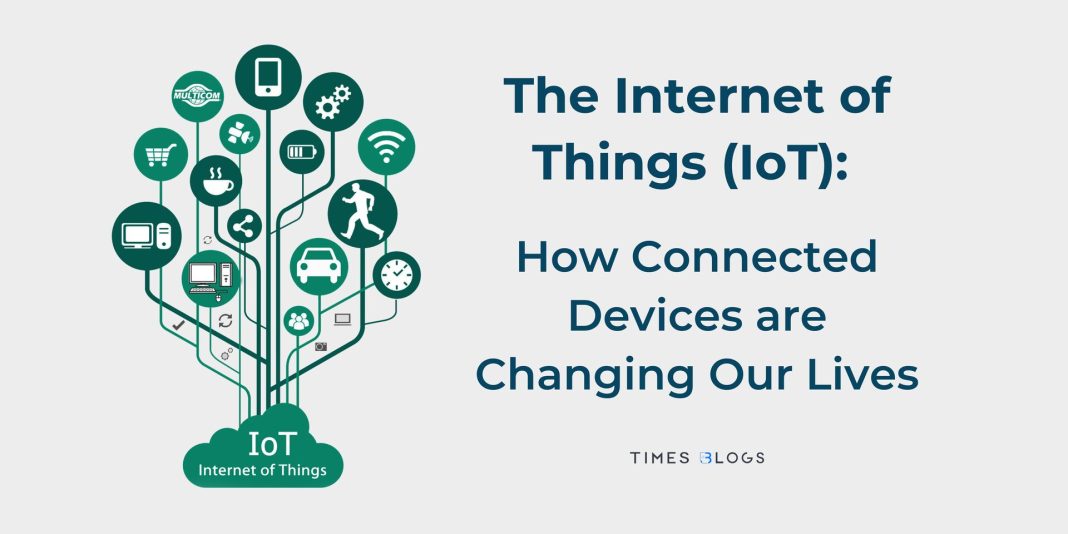Introduction
The Internet of Things (IoT) has been one of the most significant technological developments of the past decade, and its impact on our daily lives has been tremendous. The IoT refers to the network of devices that are connected to the internet and can communicate with each other. These devices can range from smartphones and laptops to smart homes, smart cities, and even smart factories. In this article, we will explore how connected devices are changing our lives and what the future holds for this revolutionary technology.
Table of Contents
What is the Internet of Things (IoT)?
The IoT is a vast network of interconnected devices that collect and share data with each other. These devices can be anything from smart thermostats and wearables to connected cars and industrial sensors. The IoT is built on a foundation of sensors, which are tiny devices that can measure different physical and environmental factors such as temperature, humidity, light, and motion. These sensors are connected to the internet and can send and receive data to and from other devices.
The IoT has many applications across different industries. For example, in healthcare, the IoT can be used to monitor patients’ vital signs and alert doctors and nurses in case of any abnormalities. In agriculture, the IoT can be used to monitor soil moisture levels and weather patterns to optimize crop yield. In manufacturing, the IoT can be used to track inventory levels and optimize production processes.
The Growth of IoT
The Internet of Things (IoT) has experienced significant growth in recent years, with the number of connected devices expected to reach 30 billion by 2025. This growth can be attributed to a number of factors, including the increasing availability of low-cost sensors, wireless connectivity, and advances in cloud computing and artificial intelligence.
One of the key drivers of IoT growth is the increasing availability of low-cost sensors. These sensors can be embedded in everything from household appliances to industrial equipment, allowing them to collect and transmit data. For example, a smart thermostat can use sensors to monitor the temperature of a room, while a fitness tracker can use sensors to track a person’s heart rate and steps taken.
Wireless connectivity is another important factor in IoT growth. Advances in wireless technologies, such as Bluetooth, Wi-Fi, and cellular networks, have made it easier and more cost-effective to connect devices to the internet. This has enabled the development of new IoT applications, such as smart homes and connected cars.
Cloud computing and artificial intelligence have also played a significant role in the growth of IoT. Cloud computing allows IoT devices to store and process large amounts of data in the cloud, making it easier to analyze and use this data to improve operations and decision-making. Artificial intelligence can be used to analyze data collected from IoT devices, enabling predictive maintenance, automated decision-making, and other advanced applications.
Another factor driving IoT growth is the increasing demand for connected devices in various industries. For example, the healthcare industry is using IoT devices to monitor patient health remotely, improve patient outcomes, and reduce healthcare costs. The industrial sector is using IoT devices to monitor and control manufacturing equipment, improve efficiency, and reduce downtime. The transportation sector is using IoT devices to improve safety, reduce emissions, and enhance the overall driving experience.
In addition to these factors, government initiatives and regulations have also contributed to IoT growth. Many governments around the world are investing in IoT infrastructure and promoting the development of new IoT applications. For example, the European Union has launched a multi-billion euro initiative to support the development of IoT technologies, while the US government has established the Smart Cities Initiative to promote the use of IoT in urban areas.
How Connected Devices are Changing Our Lives
The IoT has already started to impact our daily lives in many ways. Here are some examples:
- Smart Homes
Smart homes are houses equipped with various devices that can be controlled remotely through a smartphone or a voice assistant. These devices can include smart thermostats, smart lighting, smart locks, and smart appliances. For example, a smart thermostat can learn your temperature preferences and adjust the temperature accordingly, while a smart lock can be controlled from anywhere to grant access to visitors.
- Wearables
Wearable devices such as smartwatches and fitness trackers have become increasingly popular in recent years. These devices can track various aspects of our health, including heart rate, sleep patterns, and exercise activity. This data can be used to provide personalized health recommendations and improve our overall wellbeing.
- Connected Cars
Connected cars are vehicles equipped with various sensors and connectivity features that can communicate with other cars, traffic lights, and road infrastructure. These features can help reduce traffic congestion, improve safety, and provide drivers with real-time traffic information and navigation assistance.
- Smart Cities
Smart cities are urban areas that leverage IoT technology to optimize city services and improve the quality of life for residents. Examples of smart city applications include smart traffic management, waste management, and energy efficiency. For example, sensors can be used to monitor traffic patterns and adjust traffic lights accordingly, reducing congestion and improving traffic flow.
- Industrial IoT
The industrial IoT refers to the use of connected devices in industrial settings such as factories and warehouses. These devices can be used to monitor production processes, track inventory levels, and optimize supply chain management. For example, sensors can be used to monitor equipment performance and alert maintenance personnel when repairs are needed.
Challenges and Concerns
While the IoT has many benefits, it also presents several challenges and concerns. Here are some of the main issues:
- Security
The vast number of connected devices in the IoT creates a significant security risk. These devices can be hacked, and the data they collect can be stolen or manipulated. As more critical infrastructure is connected to the internet, the risk of cyberattacks increases, which can have severe consequences.
- Privacy
The IoT collects vast amounts of data, which can be used to track individuals’ behavior and preferences. This data can be used for targeted advertising or even shared with third parties without the user’s consent. This raises significant privacy concerns.
- Interoperability
Interoperability refers to the ability of different devices and systems to communicate and exchange data with each other. The IoT is made up of devices from different manufacturers, with different communication protocols and standards. This can make it difficult for devices to communicate with each other, leading to interoperability issues.
- Complexity
The IoT is complex and requires a significant amount of technical expertise to set up and manage. This can be a barrier to adoption for consumers and businesses that do not have the necessary technical skills.
- Energy Efficiency
Many IoT devices require constant connectivity to the internet, which can drain their batteries quickly. This can be particularly problematic for devices that are difficult to access or are deployed in remote locations.
The Future of the IoT
Despite these challenges, the IoT’s potential benefits are enormous, and the technology is only expected to grow in the coming years. Here are some of the trends that are likely to shape the future of the IoT:
- Edge Computing
Edge computing is a distributed computing model that brings computation and data storage closer to the devices that generate and consume data. This can help reduce latency and improve reliability, making it an ideal solution for IoT applications. By processing data at the edge of the network, devices can make faster decisions and reduce the amount of data that needs to be transmitted to the cloud.
- 5G Networks
5G networks are the next generation of mobile networks, offering faster speeds, lower latency, and higher capacity than previous generations. This makes them ideal for IoT applications that require real-time communication and low latency. 5G networks are expected to enable new IoT use cases such as remote surgery, autonomous vehicles, and smart cities.
- Artificial Intelligence
Artificial intelligence (AI) is increasingly being used in IoT applications to analyze data and provide insights. By using machine learning algorithms, devices can learn from data and make predictions, enabling them to make smarter decisions. For example, smart homes can use AI to optimize energy consumption based on occupants’ behavior patterns.
- Sustainability
Sustainability is becoming an increasingly important consideration for IoT applications. Many IoT devices consume a significant amount of energy, and their disposal can create environmental hazards. Manufacturers are starting to design devices with sustainability in mind, using materials that are recyclable and optimizing energy consumption.
Conclusion
The Internet of Things is changing the way we live and work, with applications across a wide range of industries. Smart homes, wearables, connected cars, smart cities, and industrial IoT are just some examples of how connected devices are transforming our daily lives. While the IoT presents significant challenges and concerns, its potential benefits are enormous, and the technology is expected to continue to grow in the coming years. By leveraging edge computing, 5G networks, artificial intelligence, and sustainability, the IoT has the potential to revolutionize many aspects of our lives and create a more connected, efficient, and sustainable world.




